When I imagine a samurai, I envision a warrior with a sword. And not just any sword, but the world-renowned Japanese katana – a curved blade engineered for cutting down foes with supreme efficiency. A Japanese battlefield conjures up more variety, with spearman and archers entering the mix.
However, Japan's ancient warriors also plied less glamorous, lesser-known and therefore possibly more interesting weaponry. Implements like the jutte and kusurigama allowed users to defend and combat the katana. Fans, smoking pipes and other weapons disguised as everyday items meant one had to be wary at all times. Other weapons, like rocket launchers, seem more fit for manga than actual battlefields.
- The Katana: Japan's Famous Blades
- Tekkan and Hachiwari: Japan's Not-So-Famous Blades
- Gunsen, Tessen, and Gunbai: Fans of War
- Kiseru Battle Pipes: Smoke Your Enemies
- Kama: The Sickle
- Manriki-kusari: The Ten-thousand Power Chain
- Kusarigama: The Best of Both Worlds
- Chigiriki: The Japanese Mace
- Yumi: Death From Afar
- Fukiya: Death From Not-So-Afar
- Fire Arrows and Bohiya
- Horokubiya: Bombs Away
- Hiya Taihou: Samurai Rocket Launchers
- Tanegashima (Japanese Matchlock): Firearms
- Shuriken: Throwing Death
- Kunai: Can You Dig It?
- Testubishi or Makibishi: Watch Your Step
- Yawara: Death In the Palm of Your Hand
- Ono: Not Just For Falling Trees
- Tobiguchi: Not Just For Fighting Fires
- Bo and Jo: The Long and Short Of It
- Kanabo
- Otsuchi: Not Just For Nails
- Kyoketsu-shoge: Rise to New Heights
- Jutte: Disarmament
- Sasumata: Restraint
- Torinawa: Rope-a-Dope Edo Style
- Naginata: The Ladies' Choice
- Shukou & Ashikou: Climbing Claws
- Tekko-kagi: Claws of Death
- Kakute: Death Rings
- Nekote: Cat Scratch Fever
- Okinawa's Weapons
- List of Japanese Weapons from the Edo Period Complete!
The Katana: Japan's Famous Blades
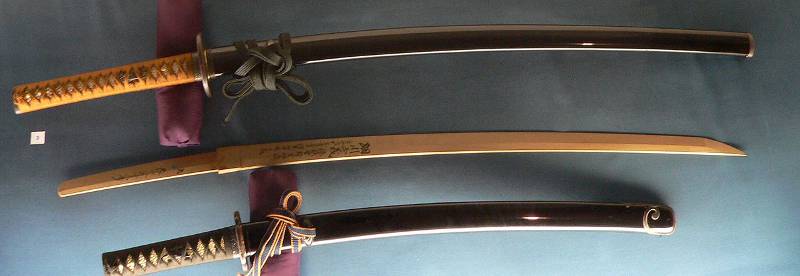
Japan's most famous weapon needs little introduction. Japanese blacksmiths' method of repeatedly heating and folding the steel made a katana's sharpness and strength unique among the world's swords. Strong enough to be used defensively but sharp enough to cut through limbs, the katana earned the reputation as the soul of the samurai – a reputation that lasted long after the samurai abandoned the sword for the pen.
Tekkan and Hachiwari: Japan's Not-So-Famous Blades


At first glance, the tekkan and hachiwari may not look impressive. The dull, heavy blades served as striking weapons made for hitting armor-clad enemies with maximum impact. Sergei Mol explains, "The tekkan was specifically developed (for use) against opponents wearing armor and is therefore necessarily heavy so that it can be used against the armor's weak points."
Also dull and heavy, hachiwari resemble the tekkan but employ a short hook at the base which may have been used to hook an opponent's armor or to gain leverage to pry the armor apart. Instead of the katana's deadly finesse, the tekkan and hachiwari aimed for heavy-handed disarmament.
Gunsen, Tessen, and Gunbai: Fans of War
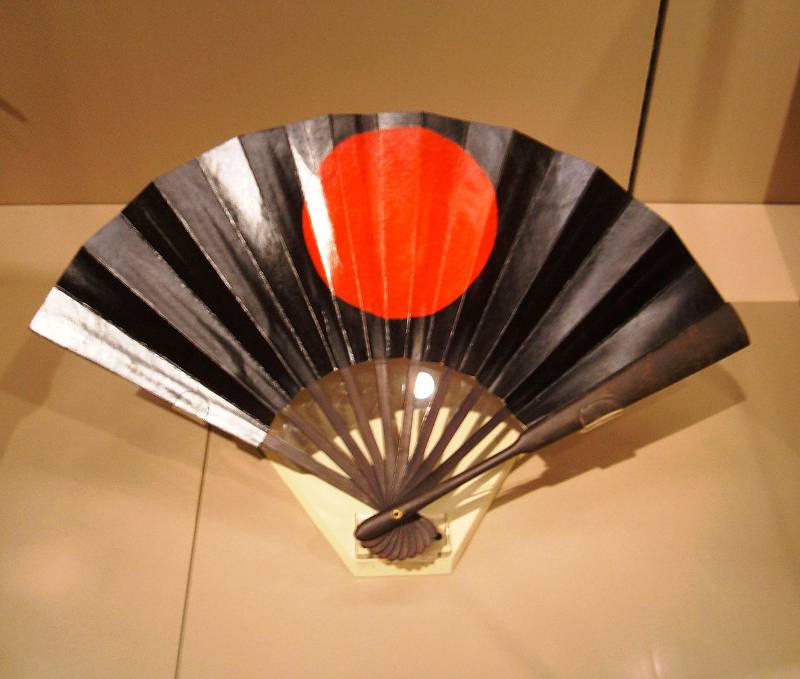
In ancient Japan even implements intended to provide relief from summer's heat and humidity became weapons. But the gunsen and tessen, foldable fans reinforced by metal plating, were only relied on as a last resort. Police officers and night watchmen used these blunt, nonlethal instruments to beat perpetrators into submission.
The subtle, but mighty fan could even defeat entire armies. Battlefield commanders carried fans as symbols of rank, but these large, solid "gunbai" also served as means of communication to deployed forces. Visible from long distances, motioning the fan directed actions on the battlefield. Today sumo referees use gunbai to alert viewers to the victors in sumo matches.
Kiseru Battle Pipes: Smoke Your Enemies
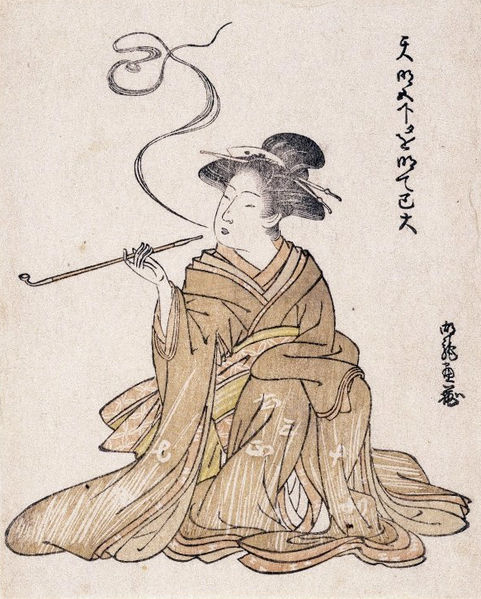
Imagine you're a pilgrim wandering the hillsides of ancient Japan. Weary from the long journey, you decide to take a break under a tree's shady branches. Just when kick back to enjoy a puff from your trusty pipe, some ruffians show up demanding money. What do you do?
If you're a badass, you beat those inconsiderate jerks with your pipe. Although not all were designed for fighting, a glance at pipe's size and weight might give away its user's intent. "Many pipes were made of metal and were… three to four feet long. Several edicts point to the fact that such pipes were used in brawls… Some pipes were fitted with regular guards, just like swords."" Battle pipes became so common, martial arts schools devised techniques in their use.
Kama: The Sickle
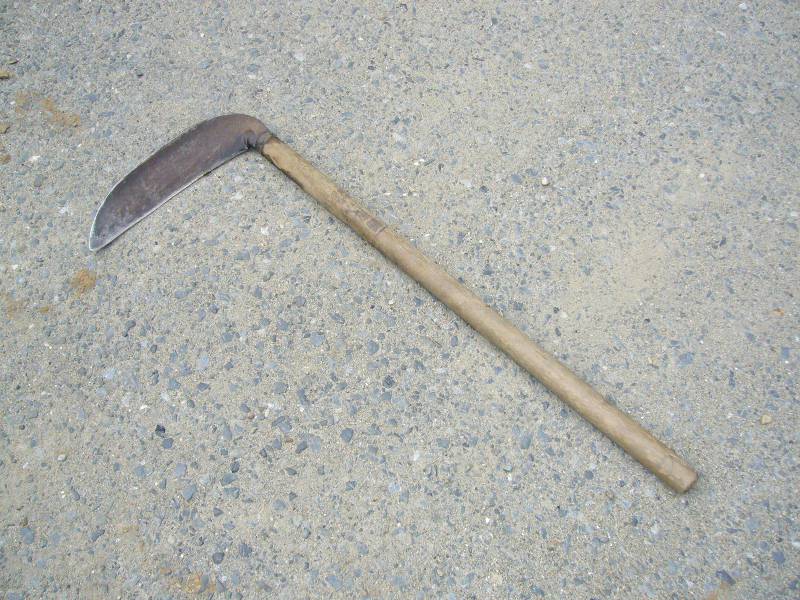
According to legend, the kama started out as a farming implement, used to cut grass and crops. However, Don Cunningham believes that the kama evolved from the jingama, a similar sickle used for clearing campsites. Either way, the weapon gained popularity among low-ranking bushi and could be used for cutting and slashing.
Manriki-kusari: The Ten-thousand Power Chain
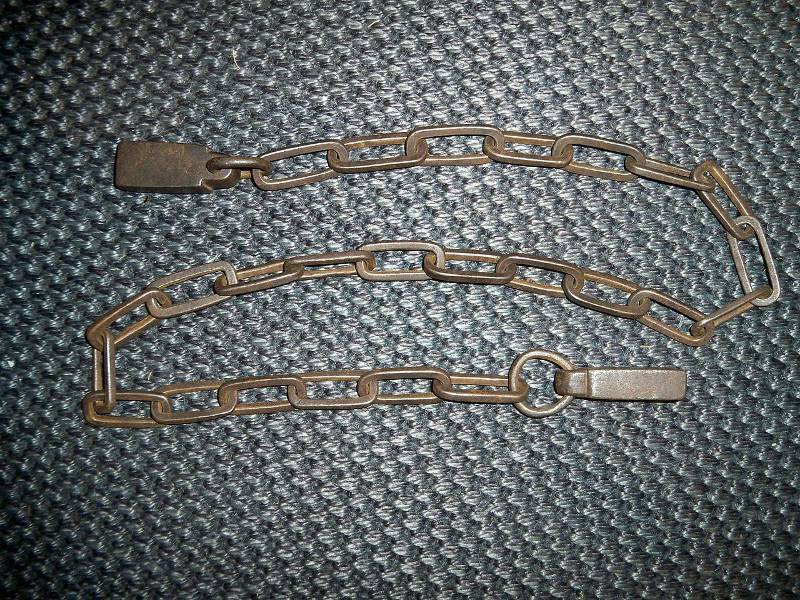
Although the manriki-kusari (sometimes called fundo-kusari or weighted chain) gained fame as a ninja weapon, police officers actually adopted the weapon to disarm and capture criminals. No matter the wielder, the versatile weapon had many advantages. The collapsable chain could be rolled up, concealed and easily transported. It could be used for climbing, restraining an enemy, and could be wrapped around body parts for extra protection.
In battle, a user could shorten his grip and taylor the length as a situation called for. Once in motion, a manriki-kusari moved at speeds that rendered it invisible. An experienced practitioner could swing the chain around himself to keep opponents at bay. Thanks to its weighted end, the manriki-kusari doubled as a projectile; its metal weight could be thrown to strike opponents. Yet unlike other throwing weapons like darts or knives which had to be retrieved to be used again, the manriki-kusari's weight returned to the hand of its wielder via its attached chain.
The manriki-kusari could also ensnare and immobilize an opponent's weapon. The swinging chain could not be cut by a blade and would instead wrap around it, making it particularly affective against the katana. Once the chain entangled an opponent's weapon a skilled user could disarm an opponent.
But manriki-kusari had disadvantages too. A difficult weapon to master, a manriki-kusari user could injure himself with the flying weight. Despite its adjustable nature, the manriki-kusari proved weakest in confined spaces like crowded or wooded areas where the chain could not be swung freely, limiting its power.
Kusarigama: The Best of Both Worlds
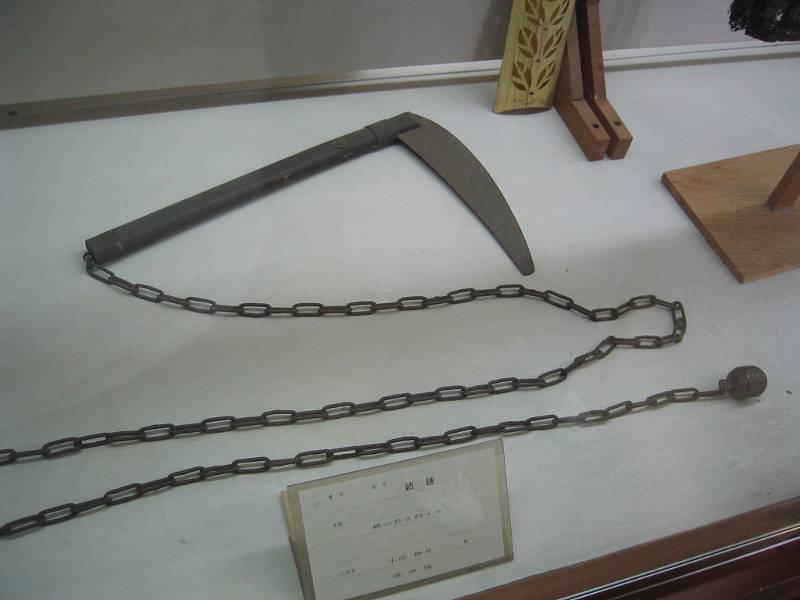
Law enforcement also made regular use of kusarigama, which combined the manrikigusari and kama. Enemies could be kept at bay by the swinging weighted chain and then slashed with the blade in close combat.
Chigiriki: The Japanese Mace
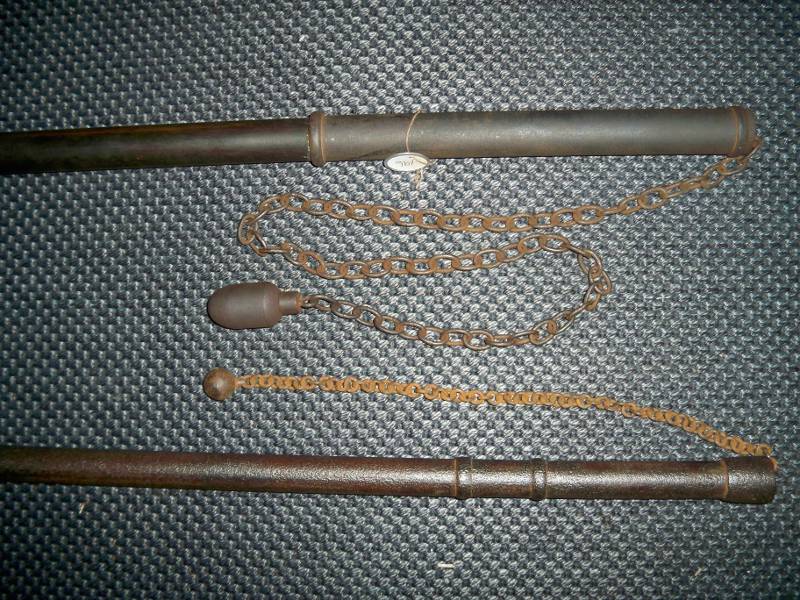
Made of wood or metal, this staff featured a weight attached to a chain at the top that was used to trip, strike, or disarm an opponent. With the chain concealed within the shaft, chigiriki could be disguised as an ordinary walking stick or staff.
Yumi: Death From Afar
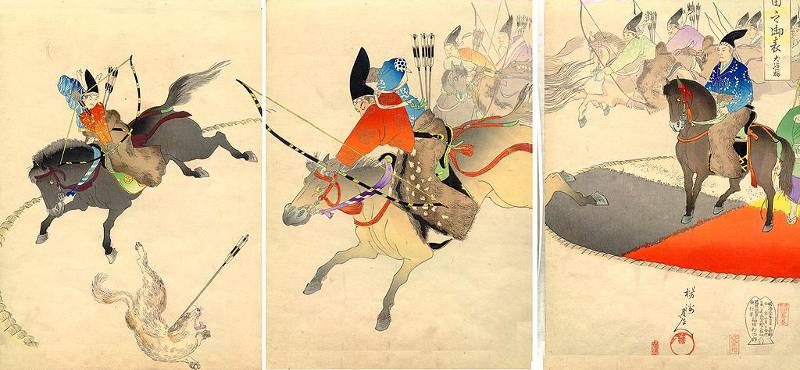
The original samurai weapon, the Japanese bow has a long and storied history. Isolation from other cultures allowed Japan to develop its own unique archery tools and techniques.
Japan's oldest hunting an ceremonial bows date back to 10,000 BCE. Without the wood binding technology of other countries, Japan developed very long wooden bows, some over 2.5 meters, to maximize their power. A low grip developed to account for the bow's length, its use from horseback, or to achieve maximum power. "Whatever the reason for its initial adoption," Friday writes, "gripping the bow two thirds of the way down its length maximizes its rebound power and minimizes fatigue to the archer far better than the more familiar centered grip."
Thanks technological limitations, Japan developed an innovative bow with a distinct shooting style that predated the katana, matchlock or rocket-launcher.
Fukiya: Death From Not-So-Afar
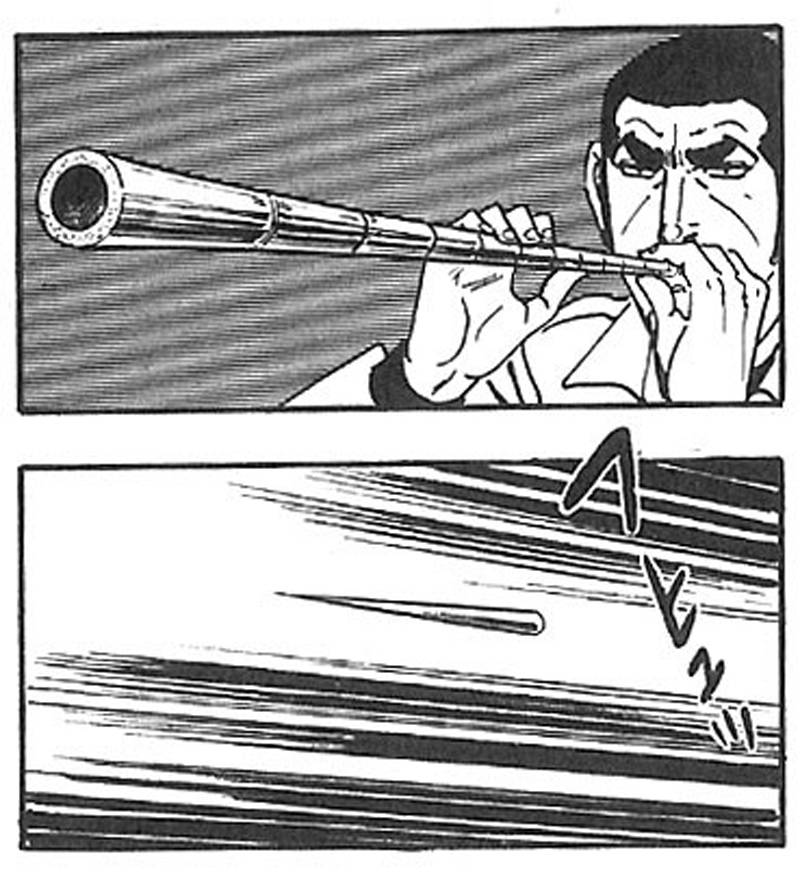
Fukiya are, without a doubt, ninja weapons, as depicted in the 17th century Mansenshukai ninja scrolls (sportsfukiya.net). Blow-darts made little noise, were easy to transport and could double as flutes, pipes, or breathing straws. In a pinch bamboo or paper could be used as substitutes. Poisoning the darts made the weapon extra effective.
But Fukiya weren't solely used as weapons. The tube could launch notes and messages to allies. Hunters also used fukiya to fell birds.
Today Fukiya has evolved into an international sport, similar to archery (fukiya.net). Capable distances range from 10 to 90 meters. Practitioners list the weapons simplicity as one of its charms.
Fire Arrows and Bohiya
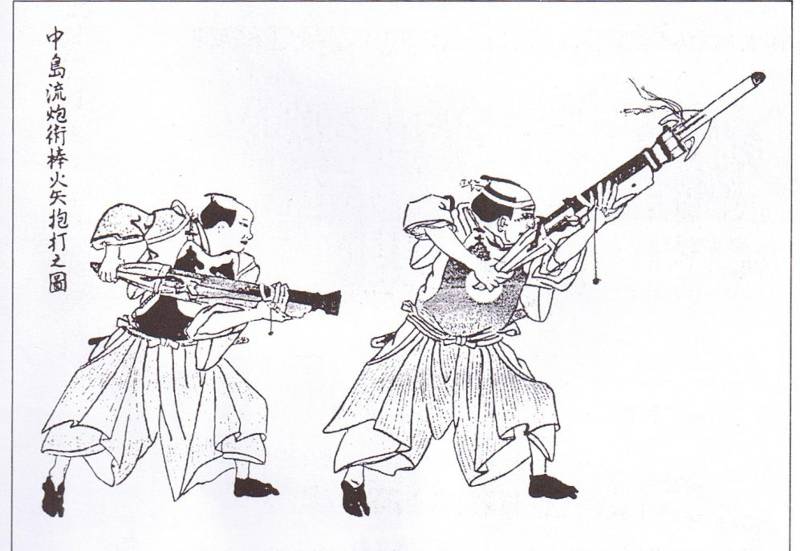
Fire arrows and miniature rockets called bohiya could wreak havoc on wooden buildings, fortifications and naval vessels. Although originally fired by bow, the Japan's introduction to gunpowder and firearm technology lead to portable, ignition-powered arrow launchers resembling rifles (wiki). "The incendiary material on the fire arrows was made from rope that had been waterproofed by boiling it in a mixture of water, the ashes of burnt cedar leaves, and a certain iron substance, all wrapped in paper with a fuse… During one seas battle we read of bohiya 'falling like rain'."
Horokubiya: Bombs Away
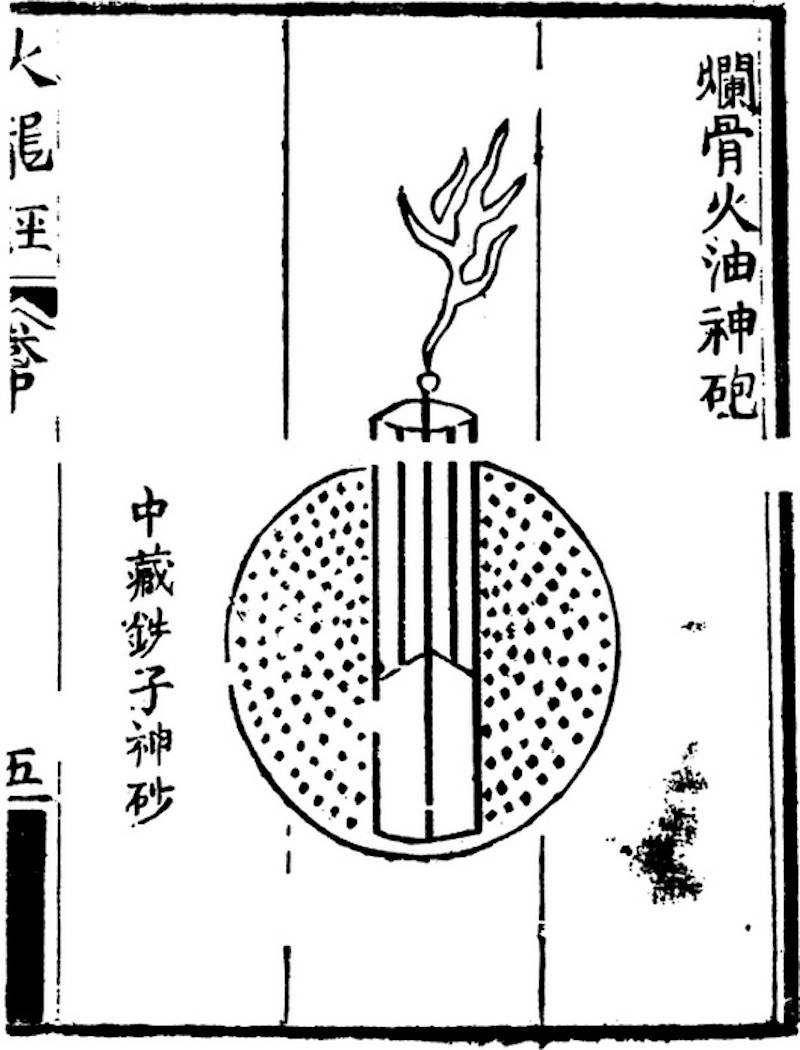
Also used in naval combat, horokubiya mimicked a Chinese technique that encased explosives in iron, ceramics or paper. The bombs were filled with gunpowder and metal shards. According to Stephen Turnbull's Fighting Ships of the Far East these bombs would be launched from a rope spun overhead or via handheld catapults resembling lacrosse sticks.
Hiya Taihou: Samurai Rocket Launchers
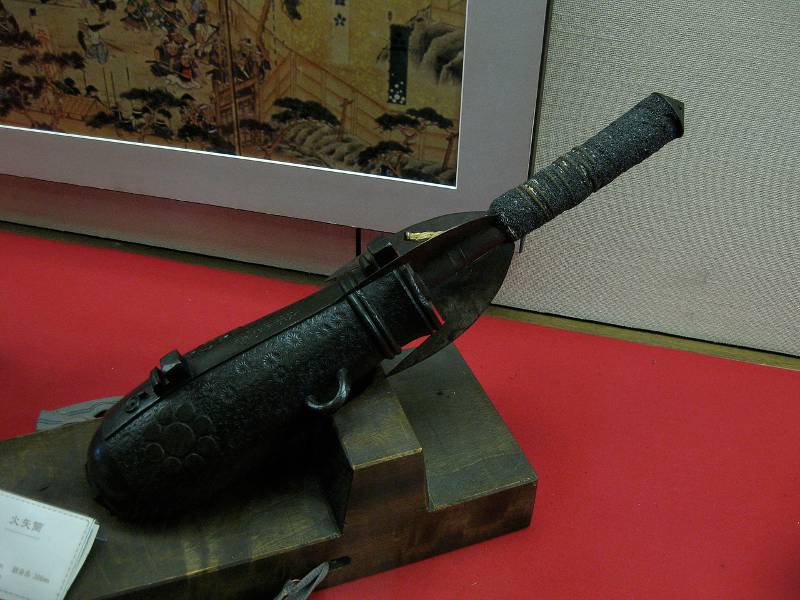
That's right, ancient Japan even had its own rocket launchers. In the mid-1500's, Portuguese firearms inspired Japanese to build their own guns and an evolved form of fire-arrows launched from portable, gun-like firearms. Mini-cannons called hiya taihou battered enemy troops and fortifications with explosive rockets made of thick wooden shafts and metal tops (wiki).
Tanegashima (Japanese Matchlock): Firearms
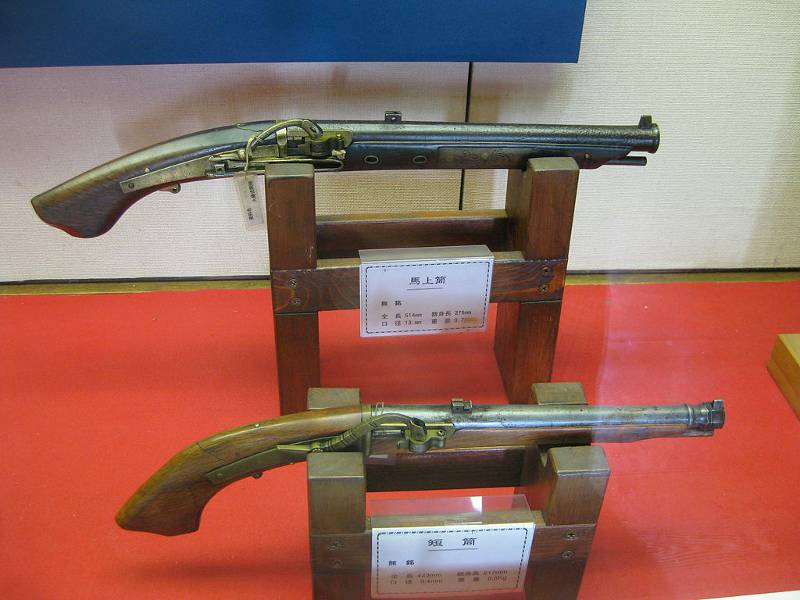
At the end of the 16th century Japan made some of the world's best firearms. And when the West had given up the matchlock for newer technology, Japan continued to innovate, even devising ways to protect the ignition mechanism from rain. The short stock and elegant style became a trademark of Japanese firearms.
Despite the katana's prominent place in Japanese warrior imagery, projectile weapons always served an important place on the battlefield and firearms proved no exception. Warlords took advantage of firearms lethal power and matchlocks became a lethal force on Japanese battlefields.
Shuriken: Throwing Death
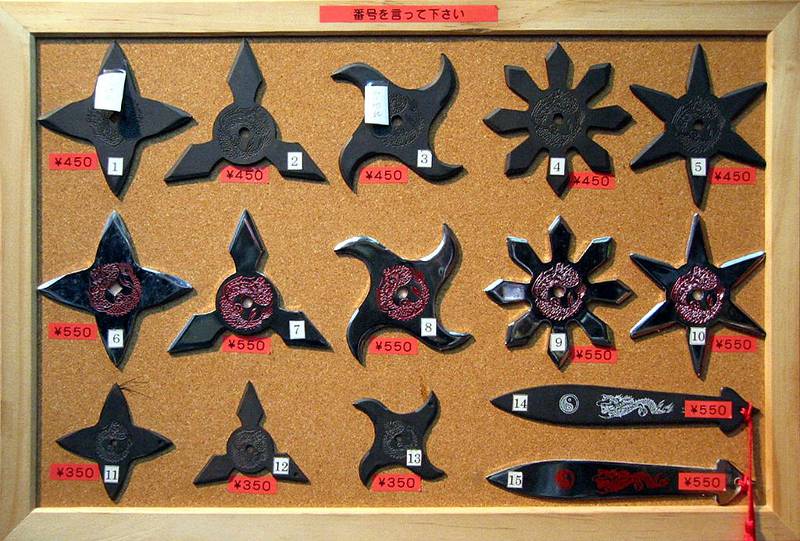
Widely known as throwing, ninja, or Chinese stars, Turnbull translates the term as "hand-hidden blade." Although they came in various shapes and sizes, the classic throwing star with multiple points spun in flight and therefore required less skill to throw than long throwing knives or other shapes.
Kunai: Can You Dig It?
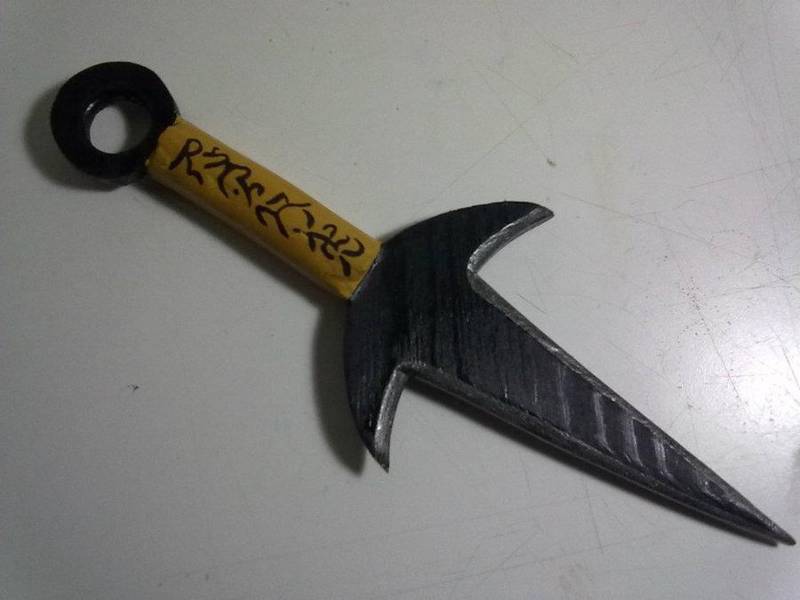
Kunai are dagger-like throwing weapons made famous in ninja anime like Naruto. However, the flat, trowel-like kunai made a better tool than projectile. Ninja used kunai for scaling and digging holes into the wattle, daub and plaster of castle walls.
Testubishi or Makibishi: Watch Your Step
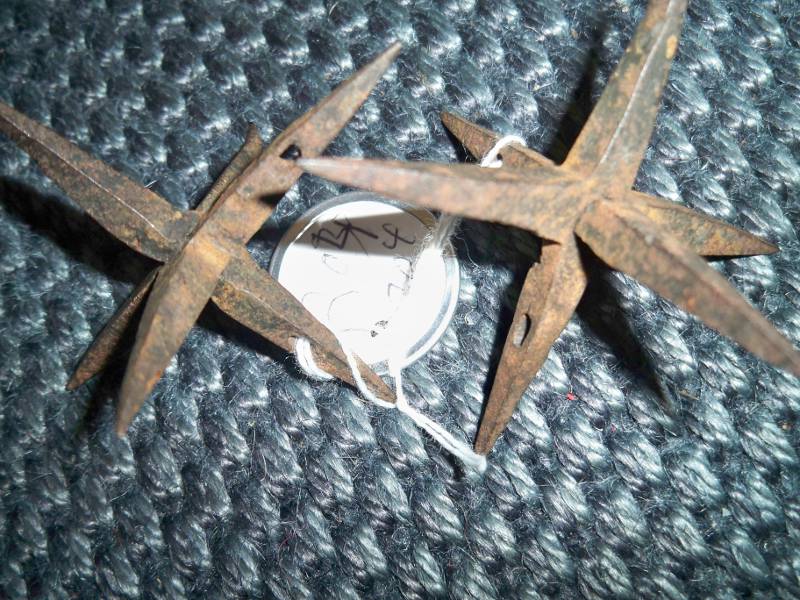
Black Belt Magazine dubbed these weapons "thorns of surprise." Small metal spikes resembling children's jacks, testubishi were thrown on the ground to slow opponents down and prevent chase. Spikes were long and sharp enough to penetrate thin soles wore at the time. As writer Tiko Yamashita points out, "They could also be wielded offensively in a counterattack." Wielders had to plan ahead, however, as the little spikes could become a disadvantage to the thrower as well.
Yawara: Death In the Palm of Your Hand
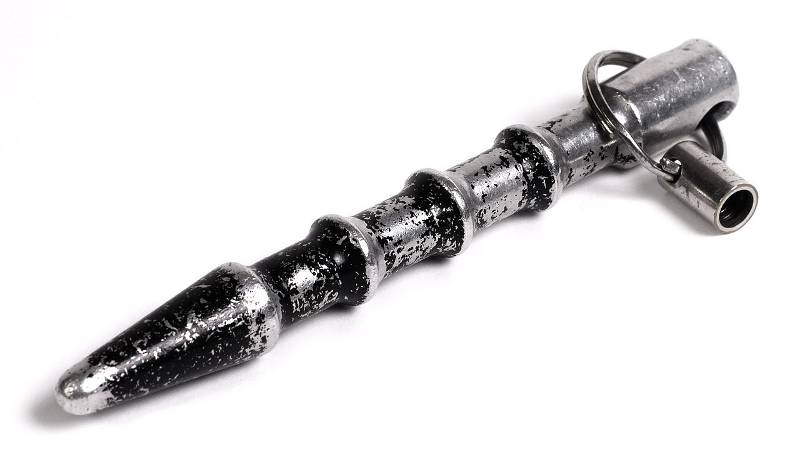
Sometimes called kubotan, yawara are small grip weapons that fit in the palm of one's hand. Though they may be pointed, yawara usually have blunt ends at each side made for striking an opponent and proved especially effective on pressure points. Rounded or hexagonal, a yawara's greatest advantage lied in gripping the weapon, which strengthened its user's punch and prevented hand breaks.
Ono: Not Just For Falling Trees
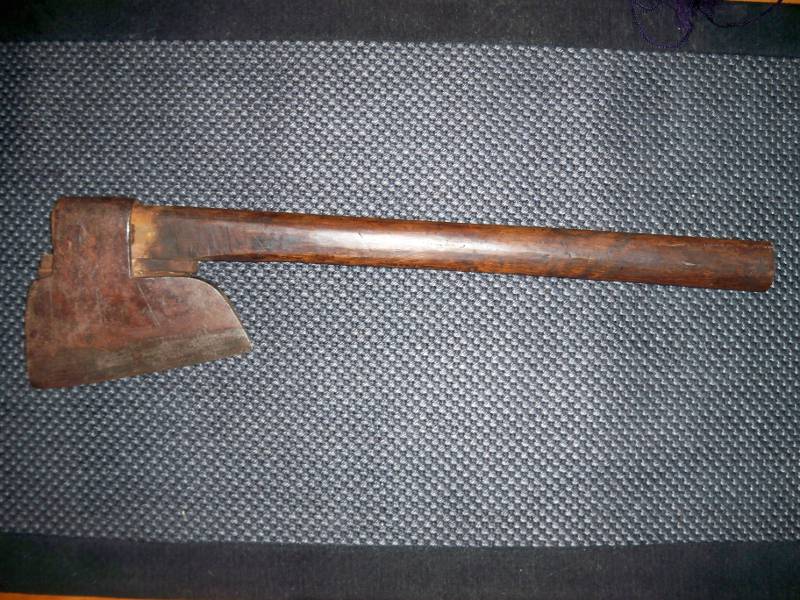
Japan's stone axes predate those of iron and steel and made ono a preferred weapon of Japan's ancient yamabushi or warrior monks. "The yamabushi used these pole-axes (some six feet tall) in the thick of battle, whirling them around at varying heights; or in individual encounters."
Tobiguchi: Not Just For Fighting Fires
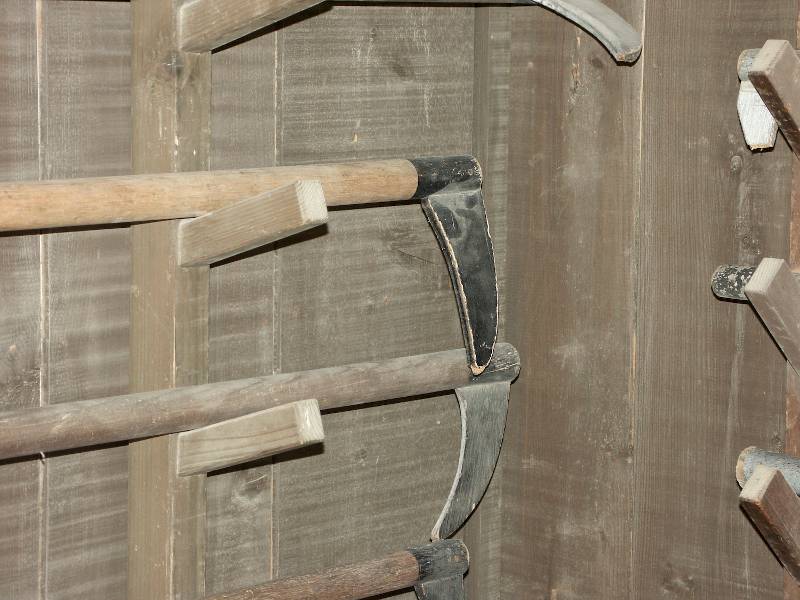
This axe-like tool acted more like a hook and was used to clear debris away from burning buildings. "Even during a fire it was important to be armed… and one had to be prepared for the possibility of someone taking advantage of the situation and attacking." As proof of their use as weaponry, some Tobiguchi featured a hook to aid disarmament. The fire tool known as "kite beak" earned the nickname (kenkatobi 喧嘩鳶 ) or "fighting kite" as it popularity among commoners.
Bo and Jo: The Long and Short Of It
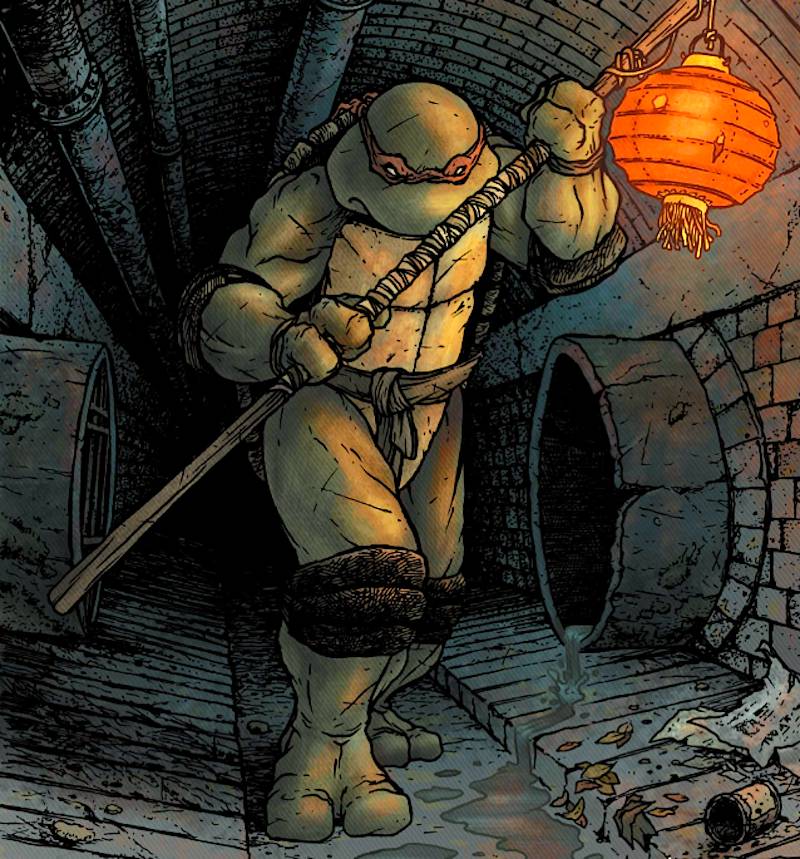
Dating back to the prehistoric aborigine, "the bo, or long wooden staff, is the most archaic of weaponry in Japan." Warriors took advantage of a bo's length, striking from afar or swinging it around to ward off enemies.
Bo come in many shapes and sizes. For example, the maru-bo is round while the hakaku-bo hexagonal. While the average bo measured 5 to 6 feet or about the height of its user, the shorter jo's length was dictated by the wielder's preference. "The humble jo seems quite plebeian. And yet, the jo possesses many of the attributes of all three of these revered arms: the striking stroke of the katana, the thrusting reach of the spear, and the reversible striking power and indestructibility of the bo."
Kanabo
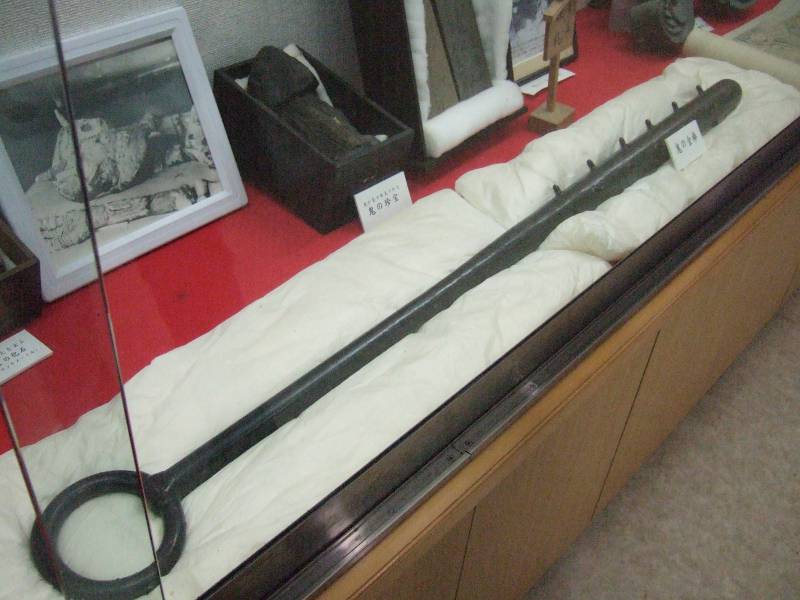
The most lethal looking of the "bo" family, the metal spiked kanabo came shaped like a bo or tapered like a bat and specialized in bludgeoning enemies. Perhaps that's why it's the preferred weapon of Japanese oni, a type of demon or ogre that frequents Japanese folktales. In fact, the image of an oni with kanabo is so powerful it became immortalized in a kotowaza (proverb), "oni with an iron club" (oni ni kanabou 鬼に 金棒) which meant invincibility.
Otsuchi: Not Just For Nails
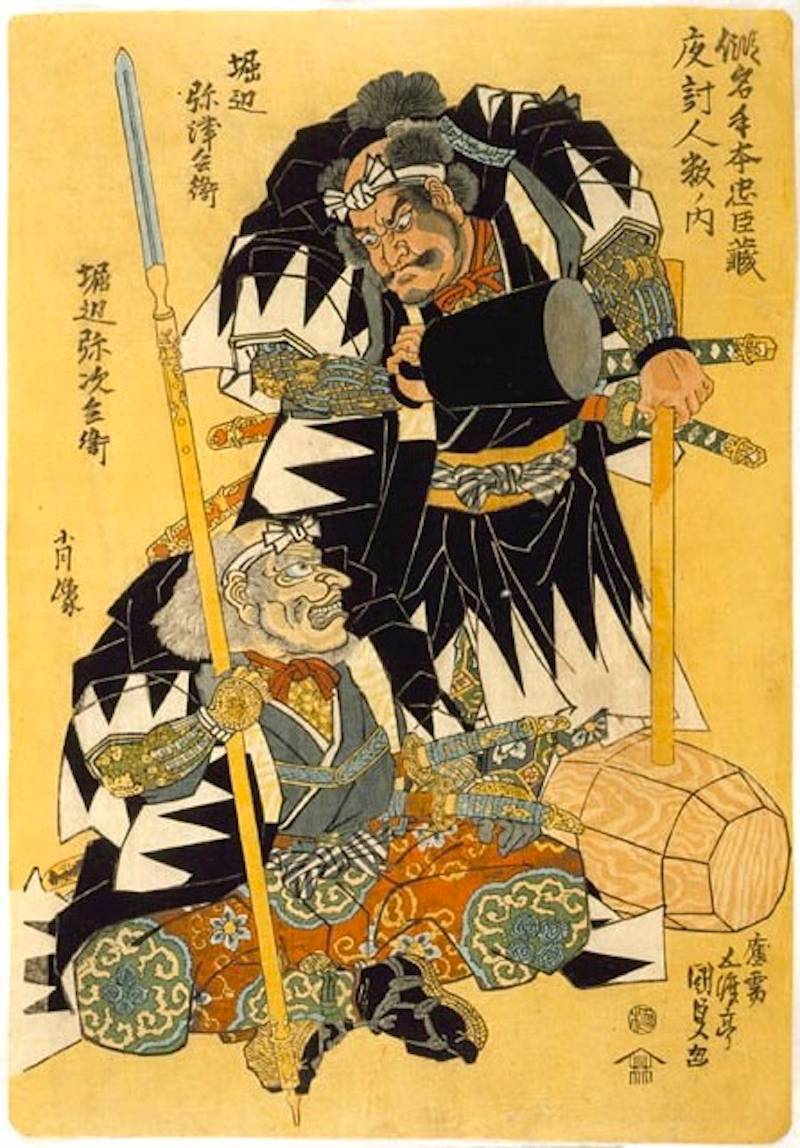
The giant battle hammer was used as a battering ram and probably smashed down more doors, gates and walls than enemies.
Kyoketsu-shoge: Rise to New Heights
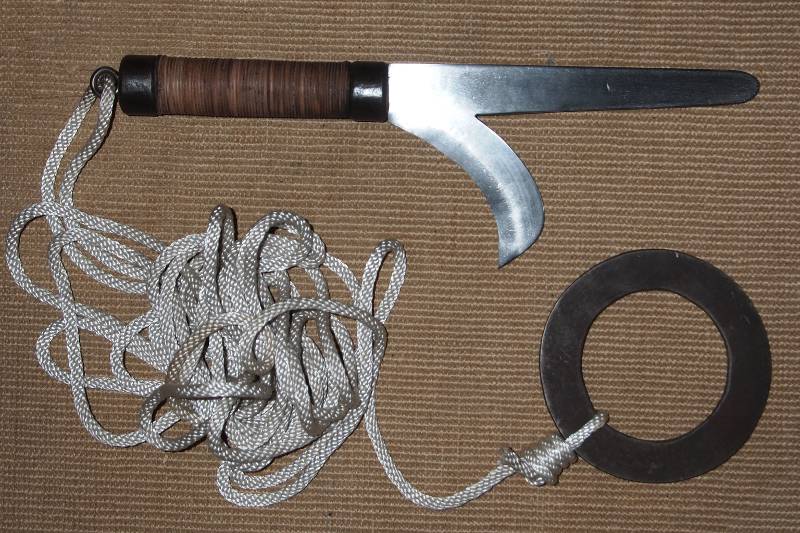
The kyoketsu-shoge consists of a hooked dagger attached to a rope with a ring-shaped weight at the end. The double edged dagger could be used for stabbing while the ring swung overhead and distracted or ensnared the enemy.
Jutte: Disarmament
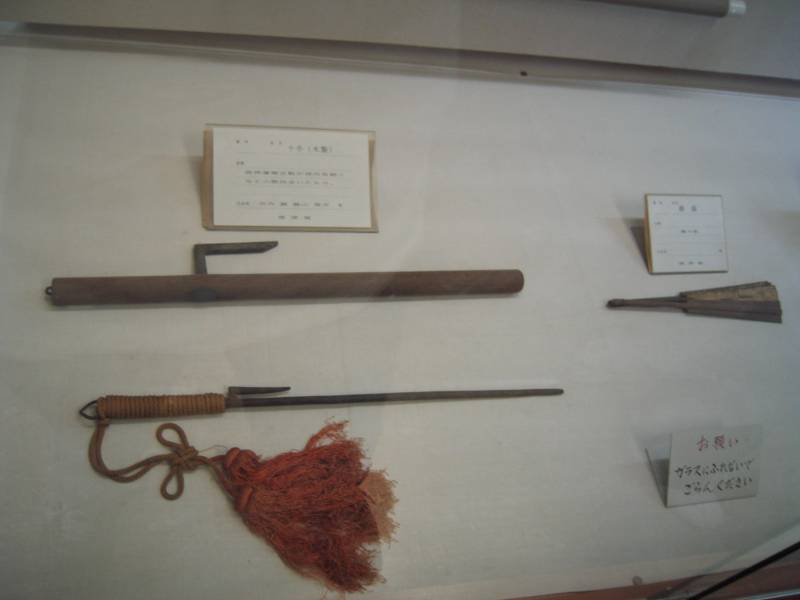
Since only top ranking police officers could carry swords, lower ranking police officers relied on alternative weaponry like the versatile jutte. The jutte could deflect sword attacks and disarm a suspect with minimal injuries. Jutte required close proximity to be useful, but once in range the weapon could strike, entangle the clothes, restrain and even throw enemies.
While many claim the kagi or hook of the jutte could be used to entrap a sword blade, David Cunningham believes the kagi served to "prevent (the jutte) from slipping through the wearer's obi (belt). The kagi may have also been used to entangle the clothes or fingers of an opponent." Common among the era's police officers, the jutte came to symbolize the job.
Sasumata: Restraint

This long pole could entrap perpetrators with the u-shaped fork at its end. The pole's protruding spikes entangled a suspect's clothes, aiding capture. But sasumata weren't limited to subduing criminals and "firefighters used similar tools to hold up ladders or manipulate buildings' beams and other structures." Today spike-less, smooth sasumata survive as restraining tools that can still be found in Japanese elementary schools, used to pacify rampaging children (an extreme rarity).
Torinawa: Rope-a-Dope Edo Style
Police used special ropes called torinawa to arrest subdued criminal suspects. "Cord loops or metal rings were often used instead of actual knots to bind the suspect… Binding someone without employing knots apparently avoided the disgrace associated with bondage." Like chain weapons, versatile torinawa were easy to transport and could be hidden under the belt or robe of an officer.
Naginata: The Ladies' Choice
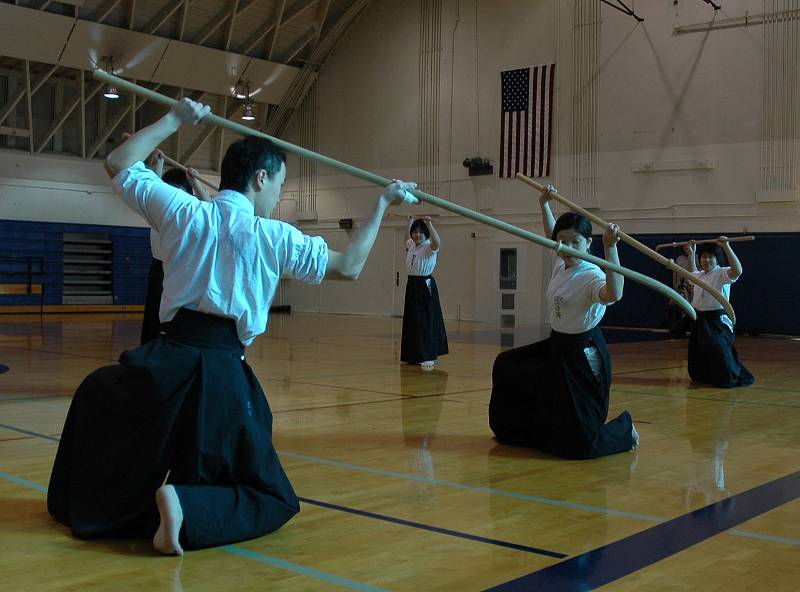
Although used by both sexes, naginata became the standard weapon of upperclass female warriors. Also known as "the woman's spear," women of the ruling classes practiced and often mastered the weapon. Although it resembles a spear, a naginata's curved blade allows for sword-like strikes instead of simple stabbing motions.
Shukou & Ashikou: Climbing Claws
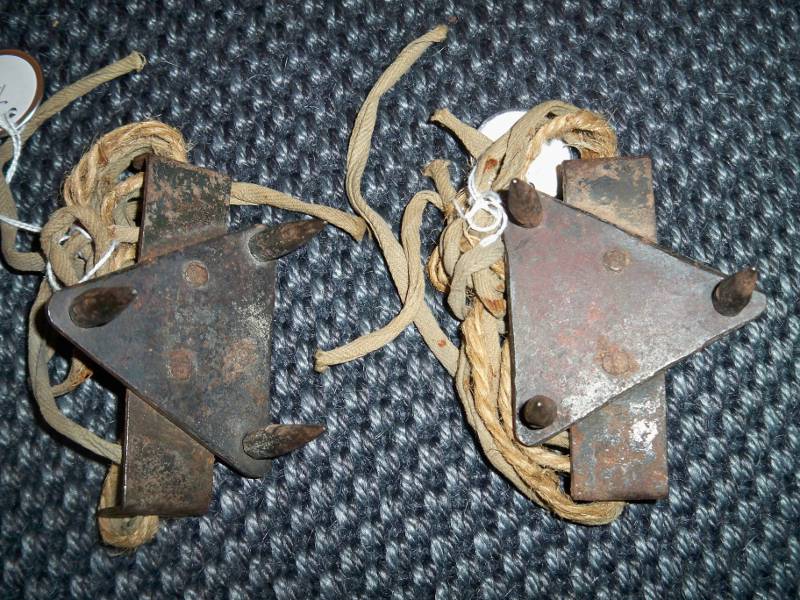
Shukou and ashikou are short spikes worn over the hands or feet. Although meant for climbing, in a pinch they could double as weapons.
Tekko-kagi: Claws of Death
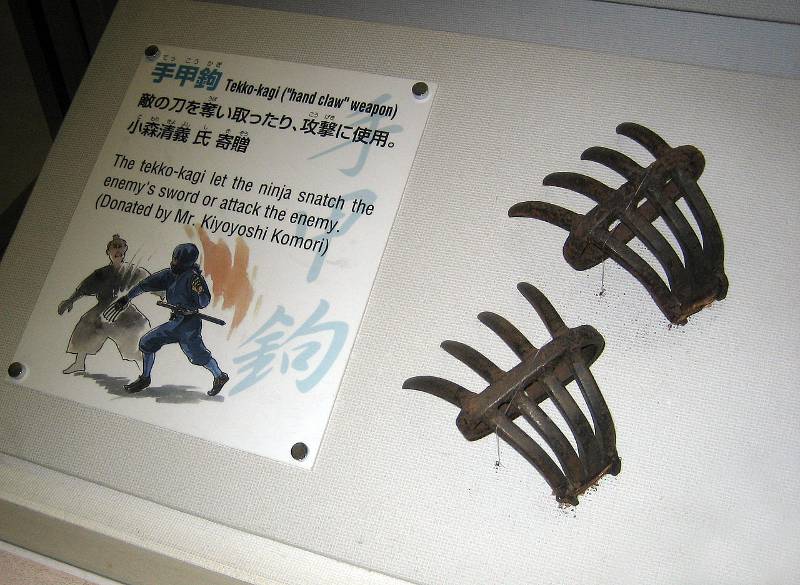
Worn over the hands, tekko-kagi's protruding metal claws could be used for scraping and striking. seo_descriptions of the techniques vary. Serge Mol explains one practice where the user wields a dagger in one hand and wears a tekko-kagi on the other. The claw allowed users to slash and defend with natural hand motions. With proper technique, even katana could be ensnared, disarmed or broken.
Kakute: Death Rings

Contrary to intuition, users wore these rings with their spikes hidden in their palms as the kakute's main advantage lay in its grip. One ring would be worn on the middle finger while a second ring could be placed in the thumb. Serge Mol writes, "The main purpose of the weapon was to gain a firm hold on an opponent, with the teeth digging into pressure points to cause pain… The surprise effect of this weapon would cause an opponent to lose concentration, making follow-up techniques easier." Like tekko, kakute could be dipped in poison for added effectiveness.
Nekote: Cat Scratch Fever
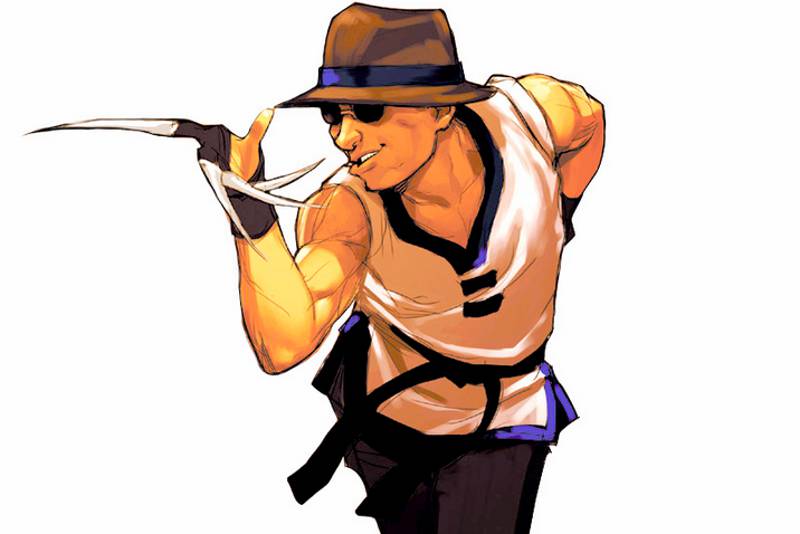
These sharp, claw-like weapons fit over the finger tips and could be dipped in poison for lethal results.
Okinawa's Weapons
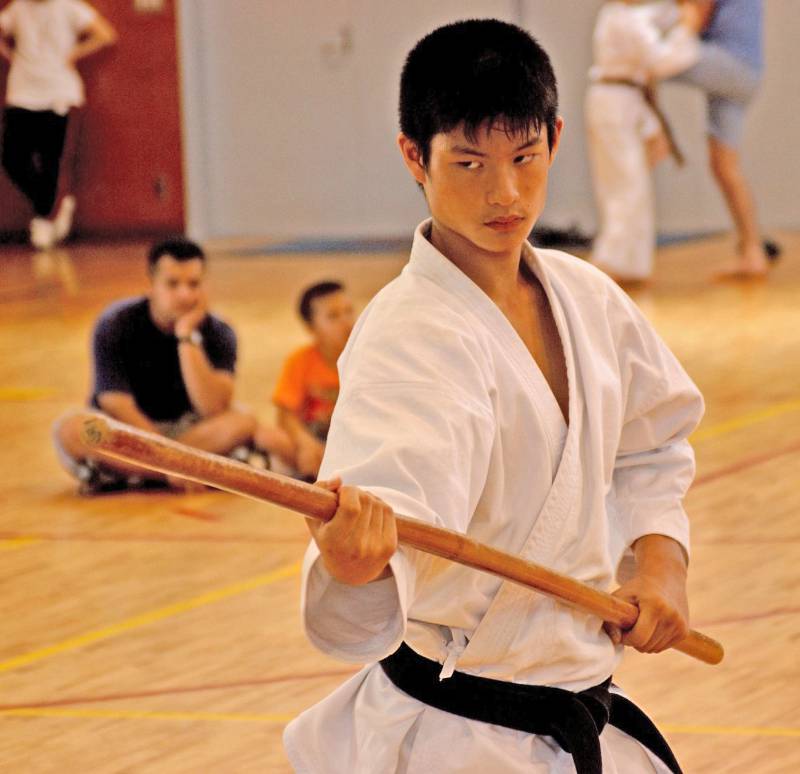
In 1609, Japan occupied Okinawa and outlawed conventional weapons to prevent rebellion. These limits inspired creativity and lead to weaponless karate and kobudo, Okinawa's unique weaponry (Yamashita 23).
Tinbe Rochin
Okinawa's tinbe rochin, a short spear and shield combo, differs from Japan's shieldless, bladed warrior culture. "The usage is more akin to a combination of Zulu fighting and European sword and small shield fighting" (rkagb). The vine, cane, metal, or turtle shell shield parried attacks, allowing users to counter opponents with upward strikes from a short spear (rkagb). Unlike the agricultural, fishing and Okinawa's other tool-based weapons, the tinbe rochin harkens back to the kingdom's ancient battle culture.
Nunchaku: Danger Sticks
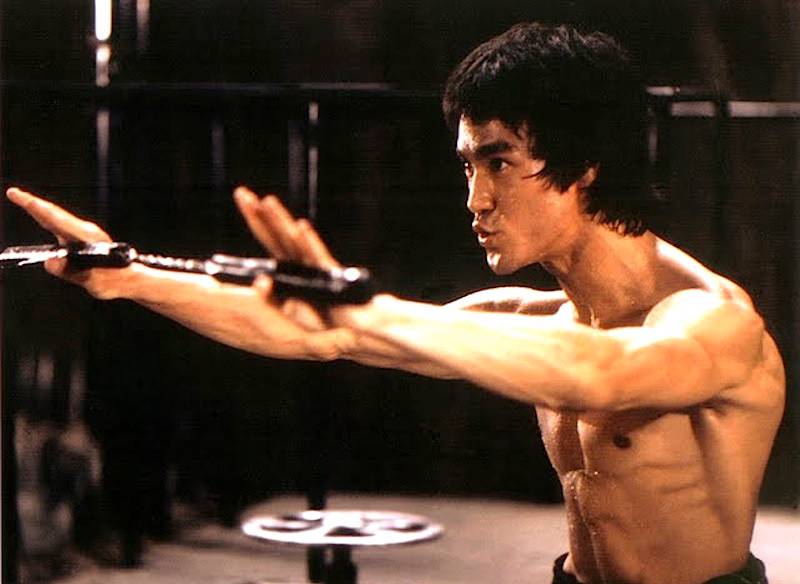
One of the most famous, glorified and downright cool weapons, legend has it that nunchaku originated as a grain pounding tool in Okinawa. Constructed by connecting two sticks with a rope or chain, nunchaku could be swung around the body for defense or wiped outwards to strike an enemy.The short sticks and foldable chain meant nunchaku could be tucked away for secrecy and easy transport.
Sai: Three Pronged Attack
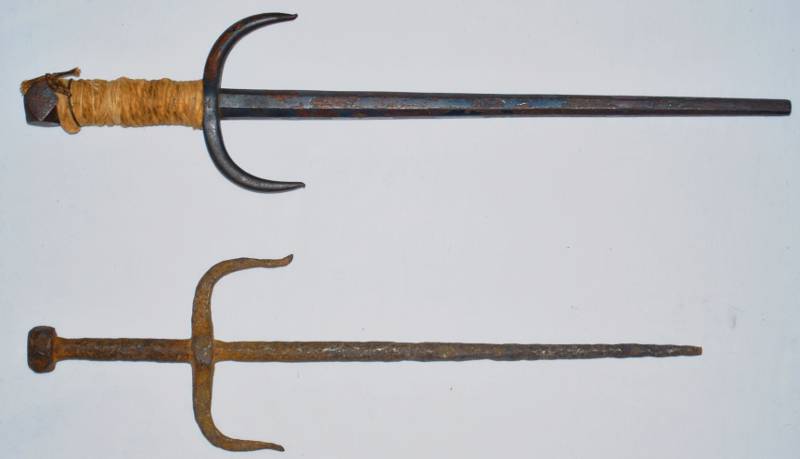
The heavy, three pronged sai traces its roots back to ancient China (rkagb). Okinawan sai are often used in pairs, though a third may be carried to replace one that has been thrown. Similar to the jutte and due to their widely spaced prongs, sai made effective defense against longer weapons like bo and katana.
Tonfa: Side-handle Baton
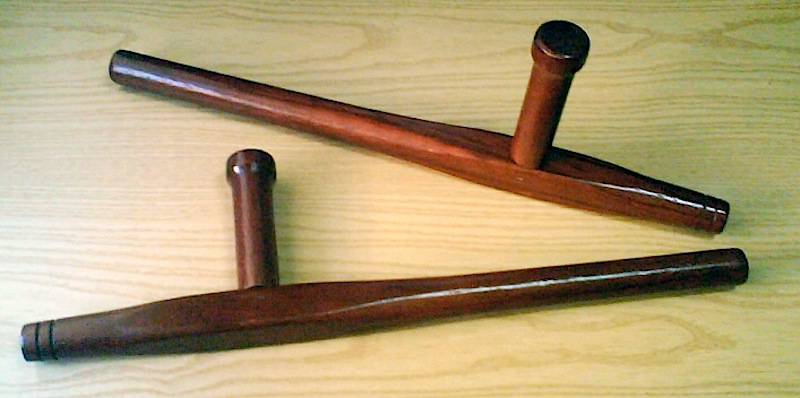
This straight wooden rod with a short, perpendicular handle started as a digging tool, cookery hook, or as the handle to a grain grinding stone (Nishiuchi). Practitioners use the tonfa as a defensive guard and striking weapon. Masters could wield the weapon in a fluid spinning motion, relying on its "centripetal force," akin to nunchaku. Tonfa are thought to have influenced the shape of modern police batons.
Eku Bo: Paddle Your Foes
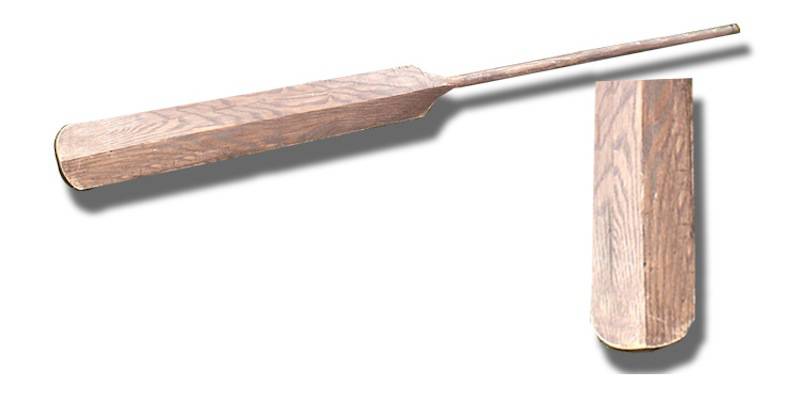
Another classic instance of a trade tool becoming a weapon, the eku bo or fisherman's oar was about six feet in length. Eku bo techniques resembled those of a standard bo staff, but the wide, heavy end made the eku bo unbalanced and more difficult to master (wiki).
Tekki and Tekko: Knuckle Dusters
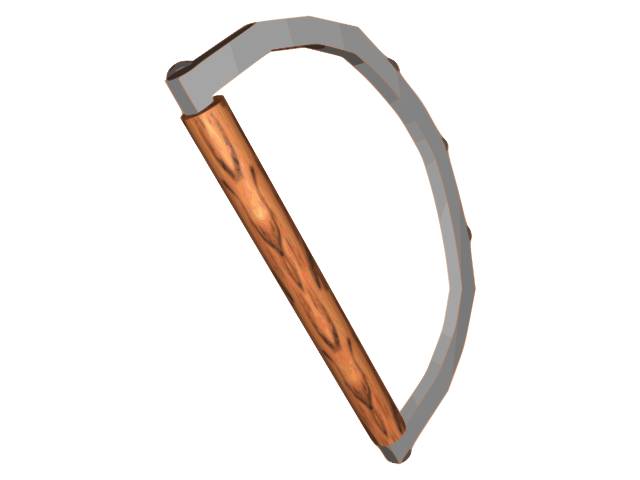
In western terms tekki and tekko would be described as brass knuckles, but I prefer the term "knuckle duster." Two similar theories explain the weapon's origin, both involving horses.
The International Ryukyu Karate Research Society explains that "the use of the tekko appears to have originated when bushi in Okinawa used the shoes of their horses as a make-shift weapon to defend themselves against a surprise attack." However, others describe the weapons as "iron stirrups gripped by the straight bar so that the curved upper portion wraps around the knuckles of the fist."
Although tekki made speedy striking weapons, they also offered defense against weapon strikes. However, their small surface area and closeness to the hand meant users had to be precise (and brave) to rely on tekki for defensive techniques.
Kuwa: Death By Hoe
What originated as a simple farming hoe, the kuwa consists of two parts, the long handle and the blade. "When holding a kuwa with the butt-end facing your opponent and the heavy metal end to the rear, the metal actually serves as a fulcrum and helps increase the speed and dynamics of the shaft. What results is a tool that can keep pace even with fast weapons, but can then follow up with punishing, heavy blows"(Ikikaiway). Although the blade dealt maximum damage, a strike with the blunt side of the blade could stun an enemy. The blade could also be used as a hook, to trip opponents.
List of Japanese Weapons from the Edo Period Complete!
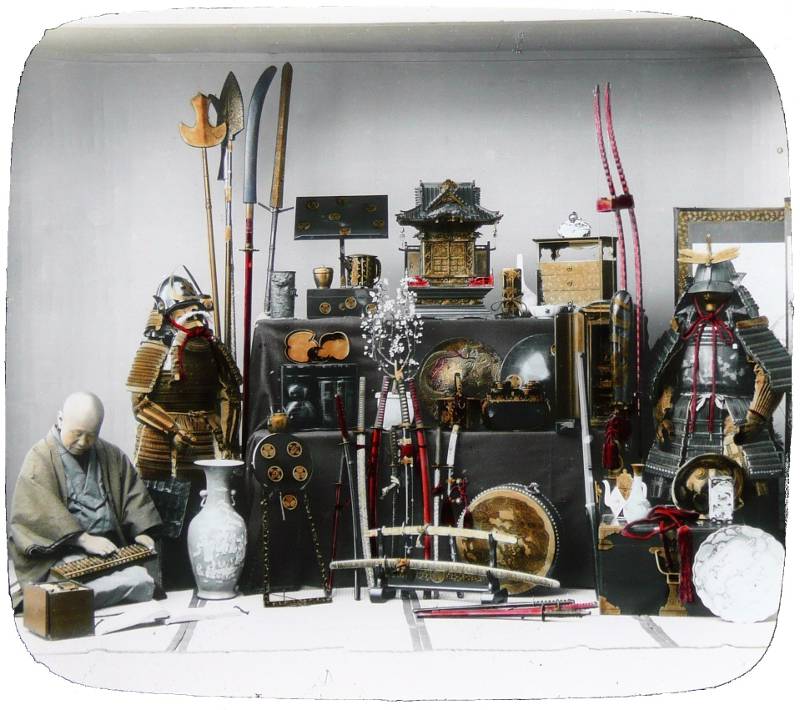
Japan's ancient fighting weapons ranged from working class tools like the kuwa and kama, to those created with deadly intent like the kanabo and katana. Jutte, sasumata, and other weapons meant to subdue opponents proved necessity is the mother of invention.
The overall variety of Japanese weapons inspires the imagination and continues to spark interest in ancient Japanese battle culture. Funny that Japan, a country that takes pride (for the most part) in its peaceful, safe reputation has such a weaponed, violent heritage.
